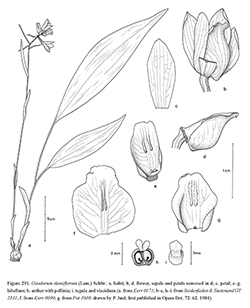e-Flora of Thailand
Volume 12 > Part 2 > Year 2014 > Page 533 > Orchidaceae > Geodorum
1. Geodorum densiflorum (Lam.) Schltr.wfo-0000971965
Repert. Spec. Nov. Regni Veg. Beih. 4: 259. 1919; Seidenf., Opera Bot. 72: 61, fig. 33. 1984; Opera Bot. 114: 333. 1992; Seidenf. & J.J.Wood, Orchids Penins. Malays. Singap.: 543, fig. 247a–e. 1992; J.B.Comber, Orchids Sumatra: 217 (incl. colour photo). 2001; N.Pearce & P.J.Cribb, Fl. Bhutan 3(3): 255, fig. 59. 2002; S.C.Chen et al. in Z. Wu et al. (eds), Fl. China 25: 259. 2009; Barretto et al., Wild Orchids Hong Kong: 347, fig. 289–292. 2011.— Limodorum densiflorum Lam., Encycl. 3: 516. 1792; Seidenf., Opera Bot. 72: 47, fig. 27. 1984. Fig. 291.
Accepted Name : This is currently accepted.
Synonyms & Citations :
Description : Corms triangular-ovoid, 4–4.5 cm long, 3–3.5 cm in diameter. Leaves 3–4, fully developed (or very nearly so) at the time of flowering, at base forming a distinct (up to 28 cm long) pseudostem; laminas elliptic-oblong to oblanceolate-oblong, (4.1–)11.7–36.2 by (1.8–)4.3–9.1 cm. Inflorescence 11.2–37.5 cm long, usually shorter than the vegetative shoot, 5- to 28-flowered; peduncle 2.5–4.5 mm in diameter, major part freely exposed between 5–7 widely spaced sheaths at the time of flowering; floral bracts acute to acuminate, 5–30 by 1–6.5 mm. Flowers mainly (greenish-)white to purplish-pink (proximal part of labellum usually with maroon to purplish-red or pale brown markings, distal part white to pink or bright yellow with red to maroon markings and/or a sulphur-yellow blotch). Sepals 3- to 5-veined; dorsal sepal oblanceolate-oblong, obtuse to acute, 7.5–17.2 by 2.3–5.7 mm; lateral sepals oblanceolate oblong, slightly oblique, obtuse to acute, 8–19.5 by 2.2–5.9 mm. Petals obovate to oblanceolate-oblong, obtuse to acute, 6.5–16(–19.5) by 2.6–8.6 mm, 5- to 7-veined. Labellum 6.8–15 by 4.1–10 mm in its natural conformation (up to 17.5 mm wide when flattened), sometimes abruptly narrowed about one third below apex, 3.4–7.2 mm wide 2 mm below apex, margin erect to slightly incurved proximally, flat to recurved or revolute distally; apex truncate, retuse; labellum ornamented by a basal, fleshy, V-shaped callus and 2–3 obscure to prominent and occasionally confluent verrucose keels extending from the central to distal part of labellum. Column 3–5.3 mm long. Capsule not seen.
Thailand : NORTHERN: Mae Hong Son (Ban Pang Mo), Chiang Mai, Lampang (Thum Chang), Phrae, Tak, Nakhon Sawan (Takfa); NORTH-EASTERN: Phetchabun (Khao Hin Prakarung), Loei (Phu Pha Man); SOUTH-WESTERN: Kanchanaburi, Ratchaburi, Phetchaburi (Khao Yoi), Prachuap Khiri Khan; CENTRAL: Saraburi (Sam Lan); SOUTH-EASTERN: Chon Buri (Si Racha), Trat (Ko Kut); PENINSULAR: Ranong, Yala (Banang Sata).
Distribution : Sri Lanka, India (iconotype), Nepal, Bangladesh, Myanmar, Cambodia, Vietnam, S China, Taiwan, Ryukyus and throughout Malesia to N & W Australia and the W Pacific Islands (south-east to Niue).
Ecology : Lower mixed deciduous forests, moist upper deciduous forests, bamboo thickets, rubber plantations and secondary growths in old clearings of lower tropical rain forests, 0–300 m alt. Flowering: mainly June–July, but also recorded in April and May.
Vernacular : Wan chung nang (ว่านจูงนาง).
Notes: Geodorum appendiculatum, a poorly known taxon originally described from Assam, was recorded for Thailand by Seidenfaden (1984) who had studied putative type material in C. However, having compared the Thai collection assigned to G. appendiculatum with the protologue of that taxon, with the putative type material in C (see discussion on this in Seidenfaden, 1984: 59–60) and with rich material of G. densiflorum from Thailand (herbarium specimens as well as live plants in situ), we are convinced that the two taxa are conspecific. The labellum ornaments are highly variable, and there seems to be a continuous series filling the gap between what Seidenfaden (1984) considered characteristic of G. densiflorum and G. appendiculatum, respectively. Consequently, we have added G. appendiculatum as a new synonym above.

